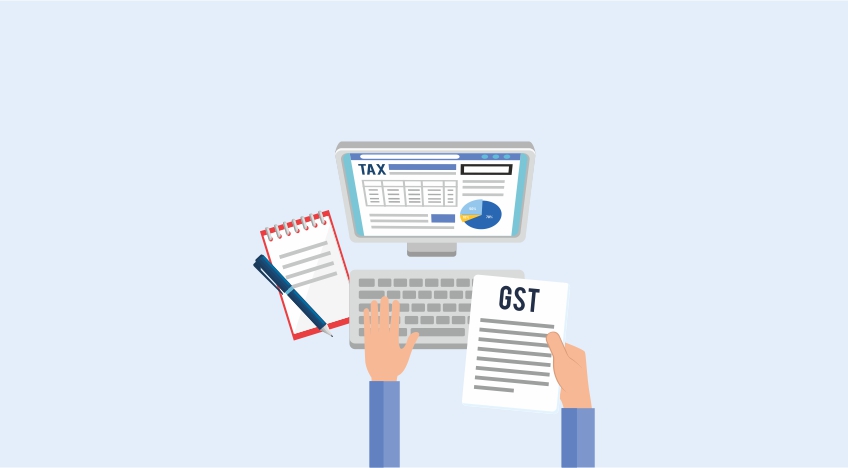Tally Solutions |Updated on: September 29, 2023
- What is GST accounting?
- Prerequisites for maintaining records and accounts under GST accounting
- Accounts to be maintained under the GST regime
- How to pass accounting entries in GST?
- Accounting entries under GST
What is GST accounting?
The Goods & Services Tax (GST) has been implemented in India since 1st July 2017. Since then, the GST Council has been working to simplify the rules to make it easier for businesses. Goods & Services Tax Law in India is a comprehensive, multi-stage, destination-based tax that is levied on every value addition.
In simple words, Goods and Service Tax (GST) is an indirect tax levied on the supply of goods and services. This law has replaced many indirect tax laws that previously existed in India.
Click here to know more about GST.
Prerequisites for maintaining records and accounts under GST accounting
Section 35 of the GST Act explains the record-keeping requirements for businesses to stay tax compliant. In April 2017, the central government also released draft rules for GST accounts and records (draft record rules), which lists additional GST accounting and record-keeping requirements.
- The business owner or the operator of the premises used for storage of goods should maintain accounts during the time in which the goods were in the storage location. This includes details regarding dispatch, movement, receipt, and disposal of goods
- The transporter of goods and services should maintain records of the goods transported, delivered, and the goods stored in transit by them
- Under the GST regime, all the records and accounts should be maintained at the primary place where all the business transactions occur. In case more than one place of business is mentioned in the registration certificate, records and accounts related to each place of business should be kept at the respective workplaces
- If the records are being maintained electronically, business owners should ensure proper back-up of the records/accounts. Also, all records must be ready to be produced, whenever demanded
- When the turnover of a business exceeds the prescribed financial limit, the business is liable for an audit.
Every business owner registered under GST must maintain the following records:
- Production or manufacture of goods - Details of all the goods manufactured or produced by the taxpayer
- Details of purchases - Details of all the inward supplies purchased by the taxpayer, including the name and address of the supplier
- Details of sales - Details of all the outward supplies sold by the taxpayer, including the name and address of the buyer
- Stock of goods - The current amount of goods available in the taxpayer’s inventory
- Input Tax Credit availed - The value of Input Tax Credit availed during the purchase of raw materials or other capital goods
- Output tax payable - The output tax payable on the sale of finished goods or services
- Output tax paid - The GST paid either by availing of input tax credit or in cash
- Any other records if required - Any additional record required by the Government for a particular business type, such as:
- Goods or services imported or exported during a tax period
- Inward and outward supplies that attract the payment of tax on reverse charge, along with relevant documents such as invoices, bills of supply, delivery challans, credit notes, debit notes, receipt vouchers, payment vouchers, refund vouchers and e-way bills.
Check out: How to make your business GST complaint!
Accounts to be maintained under the GST regime
It is crucial for every business owner to maintain the following accounts:
- Account of stock with respect to the goods purchased and sold. This account should contain all the related details like opening balance, amount of goods received and supplied, goods lost/stolen/destroyed/written off as gift or free samples, balance stock of raw materials, finished goods, scrap, and wastage
- Account of advances received and paid, along with adjustments if any
- Account of tax amounts, which contains details of tax payable, tax collected and paid, input tax, input tax credit claimed (along with tax invoice as proof), credit note, debit note, and delivery challan (issued or received during a particular tax period)
- Supplier details containing the name and address of the supplier from whom taxable goods/services, have been received
- Recipient details containing the name and address of the buyer to whom goods/services were supplied
- Address of the warehouse/garage or any other premises where the goods are stored. This includes goods stored during transit, along with the details of the stock stored at that instance
- Monthly production accounts, where the quantitative details of the following are furnished:
- raw materials used for manufacture
- goods manufactured
- waste and by-products produced in the process
- Accounts containing the quantitative details of goods used in the provision of services, details of input services utilised and the services supplied
How to pass accounting entries in GST?
Each type of GST: CGST, SGST and IGST are treated differently while calculating in your books of accounts. Let us take a look at a sample data to understand how to pass accounting entries in GST.
Intrastate transactions
Let’s say Puneet purchased cane chairs worth Rs. 1,00,000 from a GST-registered dealer within his state. The tax applicable to his purchase is 18%, which is broken down into CGST (9%) and SGST (9%). Thus, he pays a total tax of Rs. 18,000 (18% of Rs. 1,00,000) which is split equally between CGST (Rs. 9000) and SGST (Rs. 9000). He can later claim this amount as input tax credit when he has to offset his output tax liabilities.
|
ITEM |
ACCOUNT |
DR |
CR |
|
Cane Chairs |
Purchase A/c |
1,00,000 |
|
|
Input CGST A/c |
9,000 |
||
|
Input SGST |
9000 |
||
|
To Creditors A/c |
1,18,000 |
Now when Puneet sells these chairs again to another GST-registered vendor, the entry will be under Sales A/c and the CGST and SGST filed, will be that of output tax incurred. Eventually, creditors will become debtors in this case.
To give more clarity, when there is purchase, the CGST and SGST is charged as input and when there is a sale of goods and services, it is termed as output tax. Thus, the net CGST and net SGST is calculated by subtracting Output and Input.


Interstate transactions
Let’s say Puneet purchased cane chairs worth Rs. 1,00,000 from a GST-registered dealer from outside his state. The tax rate on his purchase is 18%. Thus, he pays an IGST of Rs. 18,000 (18% of Rs. 1,00,000), which he can later avail as input credit.
|
ITEM |
ACCOUNT |
DR |
CR |
|
Cane Chairs |
Purchase A/c |
1,00,000 |
|
|
Input IGST A/c |
18,000 |
||
|
To Creditors A/c |
1,18,000 |
In the next scenario, let’s say, he sold some of his chairs locally for Rs. 80,000. His output tax liability will be 18% of Rs. 80,000, for a total of Rs.14,400 that is split up equally between output CGST and output SGST.
|
ITEM |
ACCOUNT |
DR |
CR |
|
Cane Chairs |
Debtors A/c |
94,400 |
|
|
To Sales A/c |
80,000 |
||
|
To Output CGST A/c |
7200 |
||
|
To Output SGST A/c |
7200 |
He sells his remaining chairs outside his state for Rs. 50,000. The output tax liability for these will be an IGST of 18% of Rs. 50,000, which equals Rs. 9000.
|
ITEM |
ACCOUNT |
DR |
CR |
|
Cane Chairs |
Debtors A/c |
59,000 |
|
|
To Sales A/c |
50,000 |
||
|
To Output IGST A/c |
9000 |
Accounting entries under GST in TallyPrime
Below are the various accounting entries under GST and how they can be recorded in TallyPrime.
Accounting entries by business
For your business to be GST compliant in a jiffy, simply download and install Tally and follow these steps:
- Create a company
- Enable GST features
- Ledger creation
Yes, it's as simple as that!
Check out: How to record purchase and sales in TallyPrime
Also read: Why businesses need a GST software?
Accounting entries by composition dealer
Composition Scheme under GST is a relief mechanism, especially for small taxpayers, wherein they can not only have comparatively less tedious compliance practices to deal with, but also pay GST at a lower, fixed composition tax rate on their turnover. Thus, it is important for businesses to be clear about, what is the composition scheme.
GST Composite supply means a supply made by a taxable person to a recipient
- consisting of two or more taxable supplies of goods or services or both, or any combination thereof,
- which are naturally bundled and supplied in conjunction with each other in the ordinary course of business,
- one of which is a principal supply.
A principal supply on the other hand is defined as any supply which consists of goods or services and which constitutes the predominant element of a composite supply to which any other supply forming part of that composite supply is ancillary.
If you are using the GST feature provided for regular dealers to maintain your books under the composition scheme, you can now start using the GST composition features in TallyPrime, seamlessly.
Accounting entries for transactions under reverse charge
The reverse charge mechanism under GST means that the liability to pay by the recipient of supply of goods or services or both instead of supplier of such goods or services or both.
Read more about GST
Explore More Products
Latest Blogs

Nuts & Bolts of Tally Filesystem: RangeTree

A Comprehensive Guide to UDYAM Payment Rules

UDYAM MSME Registration: Financial Boon for Small Businesses

Understanding UDYAM Registration: A Comprehensive Guide

MSME Payment Rule Changes from 1st April 2024: A Quick Guide

Are Your Suppliers Registered Under MSME (UDYAM)?


